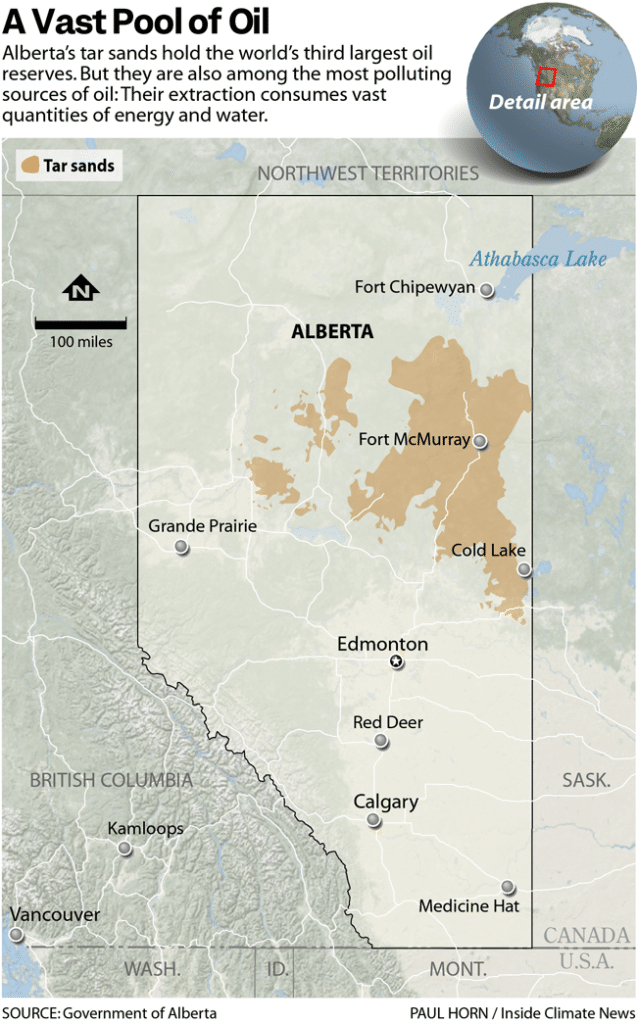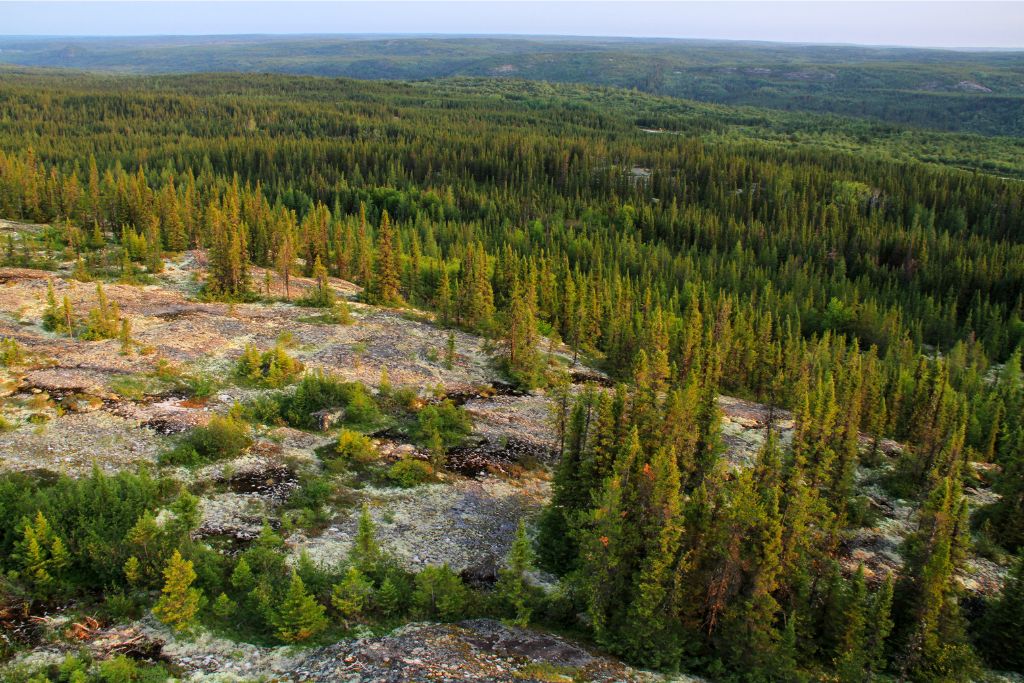Nations around the world are already bearing the brunt of anthropogenic climate change and reckless human activities that are destroying our planet and exacerbating its resources. Despite its commitment to reach net-zero greenhouse gas emissions by 2050, Canada still has a long way to go. From air and water pollution to deforestation, here are some of the most pressing environmental issues in Canada.
—
Top 5 Environmental Issues in Canada
1. Mining
First on our list of environmental issues in Canada is mining, one of the country’s most important economic sectors and a major job creator, employing approximately 700,000 people annually. Canada is a top 5 global producer of fourteen mined substances, including potash, uranium, gemstones, platinum, indium, and gold. In 2021, mining added $107 billion to Canada’s GDP, accounting for 21% of the nation’s total domestic exports.
Mining, however, has devastating consequences on the environment and is associated with forest loss, contamination of freshwater resources as well as the impoverishment and displacement of communities. Between 2008 and 2017, mining waste failures in the country have killed more than 340 people, polluted hundreds of kilometres of waterways, wiped our fish populations and jeopardised the livelihoods of entire communities.
According to MiningWatch, a non-governmental organisation based in Ottawa, Ontario, mining in Canada generates over 30 times the volumes of solid waste that all citizens, municipalities and industries combined produce on a yearly basis.
You might also like: The Environmental Problems Caused by Mining
In 2019, Former Commissioner of Environment and Sustainable Development Julie Gelfand accused the mining industry of lack of transparency following a government audit. Indeed, the department could carry out just two-thirds of its planned inspections for non-metals operations, as they did not have adequate information for all metal mines in the country.
“When environmental effects were found, there was no requirement on anybody’s part to actually have to do anything,” Gelfand said in the audit. “Nobody actually seems to have to deal with the issue.”
2. Oil Sands Pollution
Canada is the world’s fourth-largest oil producer and top exporter of crude oil to the United States, with oil refineries located primarily in Alberta. Nearly one quarter of the Western province’s economy depends on the mining and energy sector.
Alberta’s oil sands (or tar sands), a mixture of sand, water, clay, and a type of oil known as bitumen, are the world’s largest deposit of crude oil with about 1.7 to 2.5 trillion barrels of oil trapped in the complex oil sand mixture. They are also the country’s fastest-growing source of greenhouse gas emissions, releasing huge quantities of nitrogen and sulphur oxides into the air. Between 2010 and 2030, oil sands-related emissions are predicted to increase by 64Mt to about 115 Mt – a 124% rise in just 20 years. This, according to government figures, would raise oil sands’ share of national emissions from ~7% in 2010 to ~14% by the end of the decade.
Tar sand extraction, typically done through surface mining or “in-situ” mining, emits up to three times more pollution than producing the same quantity of conventional crude. It is also associated with water pollution, as it not only releases toxic pollutants into freshwater resources but also creates giant ponds of toxic waste, enough to fill more than 500 Olympic swimming pools.

Canada’s oil sands have been built on lands once home to Indigenous communities, covering an area bigger than New York City. In 2014, Stéphane McLachlan, an environmental scientist at the University of Manitoba, released a report revealing alarming quantities of toxic pollutants – including arsenic, mercury and polycyclic aromatic hydrocarbons – in the flesh of moose, ducks and muskrats in the region.
3. Depleted Salmon Populations
The Atlantic salmon has a huge cultural and economic significance in Canada. Aside from being a popular food source, the salmon is also important to forty First Nations and many Indigenous communities and is used for social and ceremonial purposes. Unfortunately, it is also one of the most endangered species in Canada, owing to the damming rivers for hydroelectric power, irrigation and flood control, which have furthered habitat loss by altering environmental flows and fragmenting habitat. Development such as dams and culverts block or impede the species’ migratory movements, from spawning to rearing, while habitat degradation and foreign fisheries further contribute to its population decline.
This is clearly evident as populations dropped to as low as 0.4 million in 1995 compared to 0.8-1.7 million between 1971-1985. As a result, the species has been the subject of conservation efforts in several countries, which appear to have been somewhat successful since the 2000s. Though it is listed as “Least Concern” by the International Union for Conservation of Nature (IUCN), it remains to be considered an endangered species in Canada.
Last year, the government committed to the development of the Wild Atlantic Salmon Conservation Strategy to restore and rebuild wild Atlantic salmon populations and their habitats. However, a recent auditor general’s report suggested that Fisheries and Oceans Canada, the government department responsible for developing and implementing policies and programmes in support of Canada’s economic, ecological and scientific interests in oceans and inland waters, is failing to protect imperilled species and that with the current federal practices, the number of species at risk is bound to increase further.
You might also like: 10 of the Most Endangered Species in Canada
4. Wildfires
Canada is home to 28% of the world’s boreal forests. With global warming bringing hotter and drier weather, these forests are becoming increasingly vulnerable to wildfires. According to the National Forestry Database, over 8,000 fires occur in Canada each year, and burn an average of over 2.1 million hectares. Forest fires result in a decline in plant diversity, damage to trees typically resistant to fires, animal displacement, and a more rapid melting of the boreal permafrost, which is associated with the release of a potent planet-warming gas known as methane.
Besides their impacts on wildlife and plant species, fires also have devastating human and economic repercussions. In the summer of 2014, over 150 separate fires broke out across the Northwest Territories, an area of about 442 square miles (580 square kilometres) in northern Canada. 13 of them were believed to have been caused by humans. The smokes they generated sparked air quality warnings across the whole country as well as in the US, with smoke visible as far away as Portugal in western Europe. A total of nearly 3.5 million hectares (8.5 million acres) of forest were completely destroyed and firefighters operations cost the government a staggering US$44.4 million.
In 2016, wildfires in Fort McMurray, Alberta burned nearly 600,000 hectares of land, destroying around 2,400 homes and buildings and forcing over 80,000 people to evacuate. In British Columbia, wildfires caused a province-wide state of emergency in 2017 and 2018.
You might also like: The Impact of Wildfires on Biodiversity and the Environment
5. Deforestation
Canada’s boreal forests play a crucial role in regulating the global carbon footprint as they store twice as much carbon as tropical forests – nearly 27 years’ worth of the world’s carbon emissions from fossil fuel consumption.
According to government figures, deforestation in Canada is among the world’s lowest, with the annual deforestation rate declining steadily over the past 25 years, and the country’s efforts in developing a sustainable forest management are praised worldwide. While this is good news, forest loss remains a pressing issue.
Canada’s top three regions were responsible for 50% of all tree cover loss between 2001 and 2021. British Columbia had the most tree cover loss at 8.59 million hectares (21.2 million acres) compared to an average of 3.59 million hectares (8.9 million acres).
Logging in Canada’s boreal forest is a huge issue and it results in 26 million metric tons of uncounted carbon emissions associated with soil emissions and lost sequestration capacity.
A 2019 study suggested that deforestation rates in Ontario are nearly fifty times higher than reported by government officials, despite the fact that only 17% of Canada’s logging takes place in the province. Here, approximately 21,700 hectares (53,621 acres) – the equivalent of 40,000 football fields – are lost each year in Ontario due to roads and landings imposed by forestry in the boreal forest. In the last three decades, a total area of 650,000 hectares – nearly 10 times the size of Toronto, the province’s capital city – has been lost due to this logging infrastructure.
Research for this article was conducted by Earth.Org research contributor Chloe Lam
You might also like: 15 Biggest Environmental Problems of 2024


















